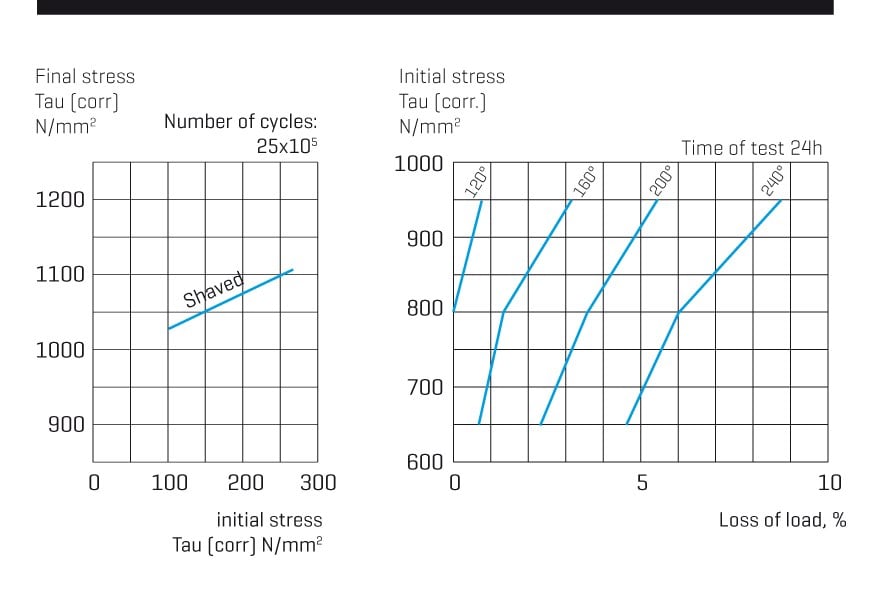1) Other wire sizes on request.
2) Ovality, i. e. the difference between the largest and smallest dimension of a cross section, is maximum half the tolerance range.
3) Conversion from tensile strength to hardness values can be calculated in standard ISO EN 18265. The tensile strength Rm within one coil does not vary more than 50 N/mm2.
4) Torsion test is carried out for assessing deformability. The fracture of the torsion test piece shall be smooth and perpendicular to the wire axis. The rupture shall show no longitudinal cracks.
For round wire
| Diameter (mm) |
Tolerance (mm) |
Tensile Strength (N/mm²) |
Torsions (l=300 mm, min. revs) |
Reduct. of area (min. %) |
| 1.60 - 2.00 |
±0.020 |
2160 - 2260 |
5 |
45 |
| 2.01 - 2.50 |
±0.020 |
2110 - 2210 |
5 |
45 |
| 2.51 - 3.20 |
±0.020 |
2060 - 2160 |
5 |
45 |
| 3.21 - 4.00 |
±0.025 |
2010 - 2110 |
4 |
45 |
| 4.01 - 5.00 |
±0.025 |
1960 - 2060 |
3 |
45 |
| 5.01 - 5.60 |
±0.030 |
1910 - 2010 |
3 |
40 |
| 5.61 - 6.00 |
±0.035 |
1910 - 2010 |
3 |
40 |
| 6.01 - 6.50 |
±0.035 |
1910 - 2010 |
|
35 |
Yield point
The proof stress Rp0.2 is min. 0.9 x tensile strength of the wire.
| Element |
Weight % |
| C |
0.50% - 0.70% |
| Si |
1.20% - 1.65% |
| Mn |
0.50% - 0.80% |
| P max. |
0.020% |
| S max. |
0.020% |
| Cr |
0.50% - 1.00% |
| V |
0.05% - 0.20% |
Cleanliness in steel
The presence of non-metallic inclusions in the wire rod is inspected for every heat of SWOSC-VHV in accordance with the Suzuki Garphyttan method by the steel supplier.
Before release for production, Suzuki Garphyttan performs non-metallic inclusion inspection for every fifth heat. The criteria for supplier inspection and releasing inspection are the following;
For wire rod samples: Inclusion size max. 15 µm down to 1 mm below surface. Inspection area: 1 000 mm2.
| Inclusion size, surface |
5-10 µm |
>10-15 µm |
>15 µm |
| Max. number of inclusions |
50 |
7 |
0 |
For SWOSC-VHV, every heat is inspected including a SEM-EDS analysis of inclusions > 10µm to verify a Super Clean composition.
As stated by IVSWMA, International Valve Spring Wire Manufacturers Association, it is likely to find occasional inclusions in valve spring quality steel of a size larger than 30 µm.
Surface condition – non-destructive testing
In the standard size range 2.00 - 6.00 mm the wire is tested continuously in Eddy Current equipment to a surface level of ≥ 40 microns. Other wire sizes on request.
Surface condition – end sample test
The wire is end sample tested by means of etch testing and binocular inspection as well as microscopical inspection of the material structure.
Max. permissible depth of partial surface decarburization and surface defects, 1 % x wire diameter. In shaved condition; for diameters <=2 .00 mm 10 µm, for diameters > 2.00 mm 0.5% x d.
Heat treatment
As soon as possible after coiling, the springs should be stress relieved.
Hot presetting
After shot peening, the springs should be hot preset or stress relieved. In order to reach optimum fatigue and relaxation properties, the springs must be preset at an appropriate stress.
Shot peening
In order to obtain optimum fatigue properties, the process time should be adjusted to get a complete treatment. Size of shots should be adapted to wire dimension, pitch and shot peening equipment.
Shot peening of the inside of the spring coils is particularly critical.
Spring conditions for test
| Spring conditions for fatigue and relaxation tests (specially designed test spring) Diagram 1 and 2: |
| Wire size |
Ø 4.00 mm |
| Diameter external |
28.00 mm |
| Spring length, l0 |
59.5 mm |
| N active |
4.80 |
| Spring index |
6.0 |
| Stress relieving |
|
| Temperature |
420 ±5°C (790 ±10 °F) |
| Time |
30 minutes |
| Shot peening (double shot peening) |
|
| 1st treatment |
Speed 56 m/sec. for 20 minutes, size of shots 0.8 mm |
| 2nd treatment |
Speed 30 m/sec. for 10 minutes, size of shots 0.8 mm |
| Hardness of Shot-peening grit (shot): |
610-670 Hv |
| Aim for Almen arc-height |
Min 0.45 mm |
Hot presetting
(theoretically set) |
1300 N/mm2 |
| Temperature |
200°C (max. 250°C) |
| Time |
10 minutes |
Relaxation and fatigue properties

In diagram 1 the fatigue properties of this grade are illustrated in a Goodman-diagram, based on a special test spring design.
Diagram 2 shows the relaxation properties (loss of load) of springs made from SWOSC-VHV wire subjected to static compression at different temperatures.
